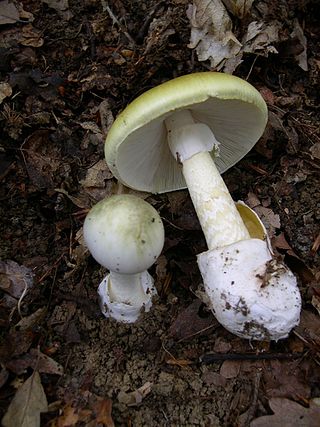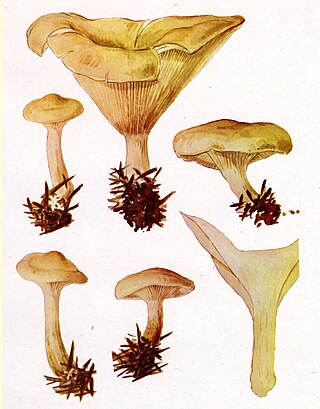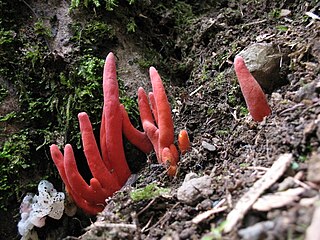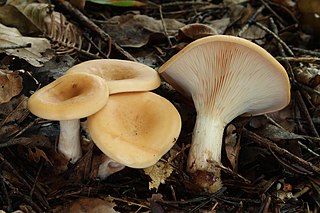
Mushroom poisoning is poisoning resulting from the ingestion of mushrooms that contain toxic substances. Symptoms can vary from slight gastrointestinal discomfort to death in about 10 days. Mushroom toxins are secondary metabolites produced by the fungus.

The Boletaceae are a family of mushroom-forming fungi, primarily characterised by small pores on the spore-bearing hymenial surface, instead of gills as are found in most agarics. Nearly as widely distributed as the agarics, the family is renowned for hosting some prime edible species highly sought after by mushroom hunters worldwide, such as the cep or king bolete . A number of rare or threatened species are also present in the family, that have become the focus of increasing conservation concerns. As a whole, the typical members of the family are commonly known as boletes.

Clitocybe is a genus of mushrooms characterized by white, off-white, buff, cream, pink, or light-yellow spores, gills running down the stem, and pale white to brown or lilac coloration. They are primarily saprotrophic, decomposing forest ground litter. There are estimated to be around 300 species in the widespread genus.

Entoloma sinuatum is a poisonous mushroom found across Europe and North America. Some guidebooks refer to it by its older scientific names of Entoloma lividum or Rhodophyllus sinuatus. The largest mushroom of the genus of pink-spored fungi known as Entoloma, it is also the type species. Appearing in late summer and autumn, fruit bodies are found in deciduous woodlands on clay or chalky soils, or nearby parklands, sometimes in the form of fairy rings. Solid in shape, they resemble members of the genus Tricholoma. The ivory to light grey-brown cap is up to 20 cm (7.9 in) across with a margin that is rolled inward. The sinuate gills are pale and often yellowish, becoming pink as the spores develop. The thick whitish stem has no ring.

Clitocybe rivulosa, commonly known as the false champignon or fool's funnel, is a poisonous basidiomycete fungus of the large genus Clitocybe. One of several species similar in appearance, it is a small white funnel-shaped toadstool widely found in lawns, meadows and other grassy areas in Europe and North America. Also known as the sweating mushroom, it derives this name from the symptoms of poisoning. It contains potentially deadly levels of muscarine.

Paralepistopsis amoenolens is an agaric fungus in the Tricholomataceae family. It is commonly known as the paralysis funnel.

Ampulloclitocybe clavipes, commonly known as the club-foot or club-footed clitocybe, is a species of gilled mushroom from Europe and North America. The grey brown mushrooms have yellowish decurrent gills and a bulbous stalk, and are found in deciduous and conifer woodlands. Although considered edible, disulfiram-like reactions have been reported after consumption of alcohol after eating this mushroom.

Trichoderma cornu-damae, formerly Podostroma cornu-damae and also known as the poison fire coral, is a species of fungus in the family Hypocreaceae. The fruit bodies of the fungus are highly toxic, and have been responsible for several fatalities in Japan. The fungus contains several trichothecene mycotoxins.

Callistosporium purpureomarginatum is a species of agaric fungus in the family Callistosporiaceae. Found in the United States, it was officially described in 1996.

Paralepista flaccida is a species of mushroom found across the Northern Hemisphere. It is known to form fairy rings.

Calonarius xanthodryophilus is a species of fungus in the family Cortinariaceae.

Paralepista is a genus of mushrooms in family Tricholomataceae. Until 2012, its member species were generally assigned either to Lepista or to Clitocybe.

Infundibulicybe gibba, and commonly known as the common funnel or funnel cap, is a species of gilled mushroom which is common in European woods.
Paralepistopsis is a genus of fungi in the family Tricholomataceae.
Leucocoprinus heinemannii is a species of mushroom producing fungus in the family Agaricaceae.
Leucocoprinus brunneotegulis is a species of mushroom producing fungus in the family Agaricaceae.
Leucocoprinus tephrolepis is a species of mushroom producing fungus in the family Agaricaceae.

Acromelic acid A is a toxic compound that is part of a group known as kainoids, characterized by a structure bearing a pyrrolidine dicarboxylic acid, represented by kainic acid. Acromelic acid A has the molecular formula C13H14N2O7. It has been isolated from a Japanese poisonous mushroom, Clitocybe acromelalga. Acromelic acid is responsible for the poisonous aspects of the mushroom because of its potent neuroexcitatory and neurotoxic properties. Ingestion of the Clitocybe acromelalga, causes allodynia which can continue for over a month. The systemic administration of acromelic acid A in rats results in selective loss of interneurons in the lower spinal cord, without causing neuronal damage in the hippocampus and other regions.

Collybia phyllophila, commonly known as the frosty funnel or the leaf-loving clitocybe, is a fungus in the family Tricholomataceae. Its epithet, meaning leaf-loving comes from its preference for leaf litter. It is common among forests in the Northern Hemisphere, and is poisonous.















